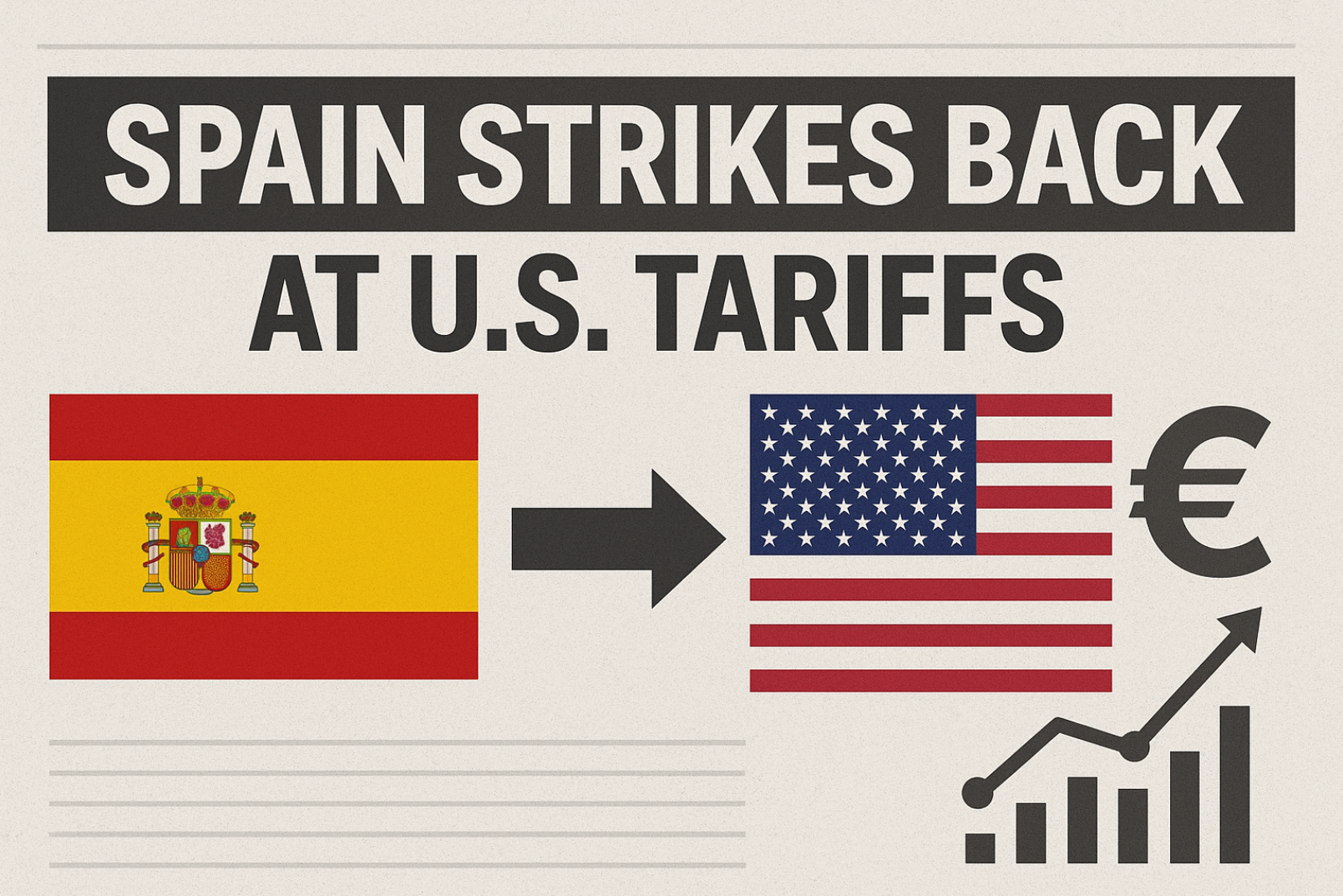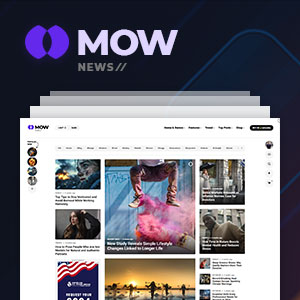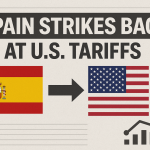In a crowded field of AI-powered trading platforms, Carivus AI (carivus-ai.com) stands out with a polished interface, automation tools, and promising features. But what truly sets it apart? Here’s a
Stepping into the world of AI trading can be overwhelming, but Liora Invest (liora-invest.com) brings clarity with a clean interface, thoughtful AI tools, and an accessible learning environment. Could it
Following Washington’s latest decision to impose 20% tariffs on European agricultural imports, the European Union has announced a robust set of countermeasures aimed at safeguarding its farmers, food industry, and
In response to the 25% tariffs imposed by the Trump administration on European steel and aluminum imports, Spain has rolled out a comprehensive set of measures designed to shield its
In today’s fast-paced digital landscape, the most successful startups are no longer relying solely on intuition or creative genius alone; they have discovered the powerful synergy between creativity and data. This blend is revolutionizing how new companies innovate, make decisions, and connect with their audiences. At first glance, creativity and data might seem like opposing forces—one driven by imagination, the other by numbers. However, in the modern startup world, they are increasingly seen as two sides of the same coin, working together to foster agility, insight, and competitive advantage. Startups that master the art of integrating data analytics into their creative processes can tailor their products and marketing strategies with unprecedented precision. Instead of relying on guesswork, these companies leverage vast amounts of data—from user behavior, social media trends, to market feedback—to inform their ideas and refine their offerings. This data-driven approach doesn’t stifle innovation; rather, it provides a solid foundation on which creativity can flourish. For example, a startup developing a new app might use user engagement data to understand which features resonate most, then let creative teams experiment with design tweaks or new functionalities accordingly. Conversely, creativity fuels data-driven strategies by pushing the boundaries of conventional thinking. It encourages startups to ask bold questions: How can we surprise and delight our users? What new markets or customer needs are currently underserved? When creative teams are empowered to interpret data through an imaginative lens, they produce solutions that are not only effective but also memorable and emotionally resonant. It’s this delicate dance—harnessing data’s objectivity while nurturing creative intuition—that defines the modern startup’s secret sauce. Many successful companies exemplify this hybrid approach. Take, for instance, a company that bases its product recommendations on detailed user data but employs creative storytelling to craft personalized marketing campaigns. Or a startup that uses data analytics to identify trending topics and then generates culturally relevant content that feels authentic and engaging. These examples showcase how blending creativity with data enhances user experience and builds brand loyalty. Moreover, this approach fosters a culture of experimentation and learning. Startups that view data not as a mere tool for reporting but as a vital partner in creative processes encourage teams to iterate quickly, learn from failures, and adapt swiftly. This mindset cultivates resilience and agility—key traits for navigating today’s competitive landscape. It also means that creative ideas can be tested rigorously, ensuring that only the most promising concepts are scaled. Ultimately, the secret of modern startups isn’t just about having good ideas or collecting vast amounts of data; it’s about knowing how to intertwine the two seamlessly. Those who succeed are the ones who see data as a source of inspiration, not just analysis, and creativity as a catalyst for translating insights into compelling user experiences. As technology continues to evolve, the companies that will thrive are those that master this delicate balance—where artistry meets analytics to forge the future of innovation.
When it comes to launching a new product, entering a fresh market, or even implementing a new process within an organization, the tendency can often be to go all in from the very beginning. The idea of scaling rapidly might seem tempting, especially in a competitive environment where speed feels like the key to capture opportunities before others do. However, jumping straight into full-scale deployment without testing can be a risky move that leads to costly mistakes, overlooked flaws, or even complete failure. That's why taking small, deliberate steps to test ideas before scaling is not only prudent but can actually be the decisive factor between success and failure. Testing ideas in small steps allows for quick feedback and learning. Instead of pouring all resources into a large rollout, you can pilot your concept on a smaller scale—say, with a limited customer segment, a prototype, or a particular aspect of your process. This approach creates a safe environment for experimentation, where errors can be identified and corrected early on, before they become widespread problems. For example, a startup launching a new app can begin with a beta version targeted at a specific user group. By observing how these early users interact with the app, what features they love, and where they encounter issues, the company gains invaluable insights that guide refinements. Another key advantage of small-step testing is risk mitigation. Large investments without sufficient validation can lead to wasted resources—time, money, and manpower—if an idea proves unviable at scale. By starting small, you reduce exposure to failure, learn more quickly, and preserve flexibility. If something doesn’t work as expected, the impact is contained, and adjustments can be made without the fallout associated with a full-scale launch. This iterative process mirrors principles found in agile methodologies and lean startup frameworks, emphasizing rapid cycles of hypothesis, testing, learning, and pivoting. Moreover, testing in smaller increments helps build momentum and confidence within your team. Achievements—no matter how modest—activate motivation and provide tangible proof that your ideas are moving in the right direction. These small wins also serve as a foundation to garner stakeholder buy-in, which is crucial when you're planning longer-term investments or organizational shifts. When stakeholders see that your approach involves careful validation, they’re more likely to support subsequent steps and scale efforts thoughtfully. Time is another critical factor. Rushing into full-scale implementation can extend timelines if problems only surface after a widespread rollout. Small tests allow for faster iterations, enabling you to adapt quickly or even abandon a flawed idea early on, rather than investing significant resources in what turns out to be a dead end. This early-stage validation accelerates the overall development process, saving valuable time and helping you avoid the pitfalls of premature scaling. Finally, testing ideas in incremental steps fosters a culture of continuous improvement. Instead of viewing a project as a one-time effort, small tests promote ongoing learning and adaptation. This mindset encourages innovation without the fear of failure, as each small experiment becomes an opportunity to learn and grow. Over time, this iterative process leads to more robust, well-tested solutions that are more likely to succeed when they are finally scaled up. In essence, embracing small-step testing before scaling is about being strategic, patient, and responsive. It’s a way to turn assumptions into validated insights, minimize risk, and build a stronger foundation for growth. When you test ideas on a manageable scale first, you position yourself for more informed decisions, greater resilience, and ultimately, better chances of long-term success in an unpredictable world.
In today’s digital age, online courses have become more than just an avenue for passive learning; they are a powerful tool for creation, innovation, and sharing one’s knowledge with a global audience. While many individuals turn to online platforms simply to acquire new skills or deepen their understanding of a subject, savvy learners are discovering that these courses can serve as launching pads for their own creative projects. The transition from learner to maker involves strategic thinking, active participation, and a mindset geared toward contribution rather than just consumption. To effectively leverage online courses for creation, the first crucial step is shifting your perspective from viewing the material solely as a resource to learn from, to seeing it as a foundation for building upon. This means engaging deeply with course content, taking detailed notes, and identifying gaps or areas where you can add your personal touch or insights. For example, if you’re enrolled in a course on digital marketing, rather than just following along with provided exercises, consider creating your own case study or campaign based on a niche you’re passionate about. This exercise not only solidifies your understanding but also results in tangible output that can showcase your skills. Another key element is active participation. Many online courses offer opportunities for discussion forums, group projects, or peer reviews. Participating actively in these spaces allows you to exchange ideas, receive feedback, and refine your work. Use these interactions as a springboard to develop original projects, whether that’s crafting unique content, designing a new product, or launching a small business idea inspired by what you’ve learned. The goal is to morph the knowledge gained into something uniquely yours. Building a portfolio is an essential step in transitioning from a consumer to a creator. As you complete various coursework and personal projects, compile everything into a centralized showcase—be it a website, a blog, or a social media channel. This portfolio not only documents your growth but also serves as a platform to share your creations with a wider audience, potentially attracting collaborators, clients, or even investors. Furthermore, aspiring creators should consider using online courses as a partnership tool. Many courses involve working directly with instructors or industry experts. Engaging actively with these mentors can open doors to mentorship opportunities, collaborations, or even content co-creation. For instance, you might create supplementary materials, write articles, or develop software tools based on the course content, thereby expanding your portfolio and network simultaneously. Also, don’t overlook the potential of online platforms to launch your own courses or workshops. As you gain expertise, you can create your own educational content, targeting niches or topics you’re passionate about. Not only does this amplify your authority in a field, but it also creates a revenue stream and a community of followers. Many successful online educators started by initially taking courses themselves — now they’re sharing their knowledge to empower others. Ultimately, the key is adopting a mindset that views online courses not just as a means to learn but as a springboard for creation. By actively engaging with content, producing original work, sharing it widely, and continuously seeking opportunities for collaboration and growth, you can turn your online learning journey into a dynamic process of creation. Whether you want to develop a new skill, launch a startup, or share your expertise, online courses can be the foundational tools that help you move from simply absorbing knowledge to making an impact.
In the world of entrepreneurship, perhaps the most vital trait a founder can possess is the ability to see opportunity where others see obstacles. This mindset—the founder’s mindset—transcends mere problem-solving; it involves a fundamental shift in perspective. When faced with a challenge, many tend to focus on the obstacles, limitations, or potential failures that lie ahead. Founders, however, train themselves to look beyond these barriers, to analyze what effective solutions or new avenues could emerge from the situation at hand. This way of thinking isn't rooted just in optimism but in a deliberate practice of reframing problems into possibilities. Take, for example, a struggling industry plagued by outdated processes or declining customer engagement. Instead of surrendering to frustration, a founder might see an opportunity to revolutionize that industry—perhaps through innovative technology, new business models, or targeted customer experiences. This mental agility often sets successful entrepreneurs apart: they ask, “What is this problem revealing about unmet needs or unexploited markets?” rather than “Why is this happening?” Building this mindset doesn't happen overnight. It requires cultivating curiosity, resilience, and a willingness to challenge assumptions. Founders constantly seek out connections between seemingly unrelated issues and are open to exploring unconventional ideas. They recognize that disruptions and setbacks often contain the seed of future success. A major part of their journey involves learning from failures, viewing each as a vital piece of the puzzle rather than as dead ends. Furthermore, the ability to spot opportunities amid problems hinges on developing a nuanced understanding of the market and customer pain points. Engaging deeply with users, listening to their frustrations, and empathizing with their journeys can reveal insights that aren’t immediately obvious. By asking strategic questions—like “How can this problem be turned into a solution?” or “What would it take to transform this obstacle into an advantage?”—founders unlock new growth avenues. It’s about shifting from a reactive mindset to a proactive one, constantly scanning the environment for untapped potential. This mindset also supports agility. Entrepreneurs who see challenges as opportunities tend to adapt more quickly, pivot when necessary, and take calculated risks. They don’t see failure as a definitive end but as part of an iterative process that refines their approach. This persistence and adaptability enable them to take advantage of emerging trends, technological advances, or shifts in consumer behavior before others even recognize them. Ultimately, cultivating a founder’s mindset transforms how problems are perceived and addressed. It’s a powerful tool for innovating and building resilience in an unpredictable business landscape. By training oneself to see potential where others see problems, entrepreneurs can unlock opportunities that lead to not just survival but thriving success. This shift in perspective is what separates entrepreneurs who merely react from those who proactively create and shape their future.
In recent years, the landscape of work has undergone a dramatic transformation, with remote work shifting from a niche perk to a fundamental aspect of professional life for millions worldwide. This shift has brought numerous benefits—flexibility, reduced commuting times, and the freedom to craft personalized work environments—but it also presents unique challenges. Without the traditional office setting, employees often struggle with feelings of isolation, distractions, or ergonomic discomfort. Fortunately, technology has risen to meet these hurdles, offering innovative solutions to make remote work more comfortable, efficient, and even enjoyable. One of the most crucial areas where technology has made a difference is in creating a productive environment. Advanced noise-canceling headphones, for instance, help filter out household distractions, allowing workers to focus deeply on their tasks. These devices have become indispensable, combining comfort with cutting-edge sound technology. Alongside audio equipment, ergonomic accessories—such as adjustable standing desks, supportive chairs, and monitor stands—have gained popularity, enabling individuals to tailor their workspace to their unique needs. Many companies now offer subsidies or recommendations for ergonomic setups, recognizing that physical comfort directly impacts productivity and well-being. Connectivity remains a cornerstone of remote work, and here, the evolution of high-speed internet and powerful connectivity tools is vital. Mesh Wi-Fi systems ensure consistent, reliable online access throughout a home, eliminating frustrating interruptions during video calls or data transfers. For seamless communication, a suite of collaboration tools—video conferencing platforms like Zoom, Microsoft Teams, and Slack—have become essential. These tools foster real-time interaction, facilitating everything from quick check-ins to complex project management, helping remote teams stay connected and engaged. Beyond communication, productivity-enhancing technologies have gained prominence. Cloud storage solutions such as Google Drive, Dropbox, and OneDrive enable easy file sharing and real-time collaboration on documents, eliminating the constraints of physical proximity. Time management apps and virtual focus timers, like Focus@Will or Pomodoro timers, support disciplined work routines and help prevent burnout. Furthermore, emerging innovations are making remote work even more comfortable. Virtual backgrounds and virtual reality platforms are creating immersive meeting experiences, reducing the feeling of disconnection that often accompanies virtual communication. AI-powered assistants and scheduling tools streamline daily tasks, managing appointments or suggesting optimal work-break cycles based on individual productivity patterns. Health and wellness technologies, including fitness trackers and fatigue monitoring apps, remind workers to take regular breaks, stretch, and maintain healthy habits. As remote work continues to evolve, technology remains a pivotal ally in shaping a workspace that is not just functional, but also comfortable and conducive to well-being. By leveraging these tools and solutions, individuals can craft an environment that boosts productivity while safeguarding their physical and mental health—making remote work a truly sustainable and satisfying way to earn a livelihood.
Keeping a personal idea journal is a powerful way to nurture creativity and organize your thoughts for future projects. In a fast-paced world filled with distractions, having a dedicated space to jot down ideas as they come can make all the difference in turning fleeting thoughts into tangible creations. Whether you're an artist, writer, entrepreneur, or someone simply eager to cultivate more innovative thinking, maintaining a personal journal provides a sanctuary for your inspiration. The key is to create a system that fits seamlessly into your daily routine, making it easy and enjoyable to capture those sparks of inspiration before they fade away. Start by choosing your preferred medium—some prefer traditional pen and paper for the tactile feel and reduced digital distractions, while others opt for digital tools like apps or notebooks that sync across devices. Regardless of your choice, consistency is essential; develop a habit of noting down new ideas as they occur rather than relying on memory alone. This could mean setting aside a few minutes each day or carrying your journal with you at all times for spontaneous entries. Over time, these scattered notes can be reviewed, organized, and expanded into more detailed plans. Effective journaling also involves categorizing your ideas. Create sections or tags for different project types, themes, or areas of interest. This way, when you're ready to dive into a new endeavor, you can easily locate related thoughts. Don't worry about creating perfection—your journal is a personal space, not a formal publication. Use sketches, mind maps, bullet points, or even doodles to express ideas vividly and intuitively. As your collection grows, revisit past entries periodically, reflecting on how your thoughts have evolved and identifying promising concepts to develop further. Moreover, cultivating a mindset of curiosity and openness encourages more spontaneous entries. Sometimes, an unrelated observation or a casual remark can spark a breakthrough idea for a future project. By documenting everything, you're building a reservoir of inspiration that you can draw from when facing creative blocks or planning your next steps. Ultimately, a personal idea journal is not just a collection of thoughts—it's an evolving tool that sharpens your creativity, clarifies your vision, and unlocks endless possibilities. With patience, dedication, and a bit of organization, you'll find it becomes an invaluable companion on your journey to turn ideas into reality.
- 1
- 2


















